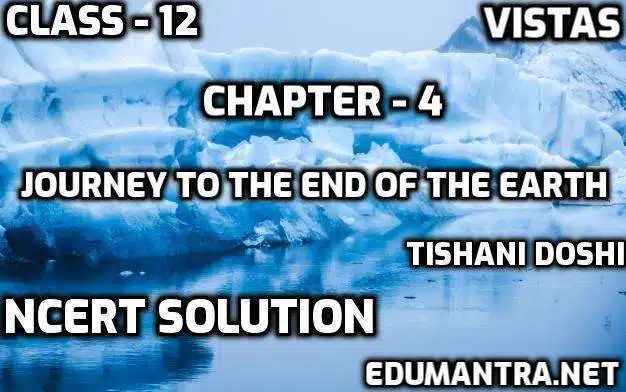
Journey to the End of the Earth
Reading with Insight
1. ‘The world’s geological history is trapped in Antarctica.’ How is the study of this region useful to us?
Ans: The world’s geological history is trapped in Antarctica. This is because the modern world is battling with an increasing population and the excessive burning of fossil fuels has created a blanket of carbon dioxide around the world which is increasing the average global temperature. The concretization of land has worsened the situation. But Antarctica is relatively untouched in this respect since it has never had a human population.
Antarctica is a crucial element in the debate on climate change because it is relatively ‘pristine’. More importantly, it holds in its ice-cores half-a million-year-old carbon records, trapped in its layers of ice. It embodies all that is prehistory: cordilleran folds, pre-Cambrian granite shields, ozone and carbon; evolution, and extinction. Hence, to study and examine the earth’s past, present, and future, Antarctica is the best place to go. These are the factors that make Antarctica very important, geologically.
2. What are Geoff Green’s reasons for including high school students in the ‘Students on Ice’ expedition?
Ans: ‘Students on Ice’ is an award-winning program offering unique learning expeditions in the Antarctic and the Arctic. Its mandate is to provide students from around the world with inspiring educational opportunities. It aims to do exactly this by taking high school students to the ends of the world and in doing so, help them foster a new understanding and respect for our planet. It has been in operation for six years now; headed by a Canadian, Geoff Green, who initially took celebrities and the retired, rich, curiosity-seekers. He then felt that they could only ‘give’ back in a limited way. With ‘Students on Ice’, he is optimistic because the students are the future generation of policy-makers. Green’s programme offers a life-changing experience at a young age which would help the students absorb, learn, and most importantly, act for the benefit of the planet.
3.’Take care of the small things and the big things will fall into place.’ What is the relevance of this statement in the context of the Antarctica environment?
Ans: Antarctica, because of its simple ecosystem and lack of biodiversity, is the perfect place to study how little changes in the environment can have big repercussions. The single-celled plants, phytoplanktons, are the grasses that nourish and sustain the entire Southern Ocean’s food chain. Further depletion in the ozone layer would affect the phytoplankton, which in turn would affect the lives of all the marine animals and birds of the region and the global carbon cycle. In the allegory of the phytoplankton, there is a great lesson for existence. If one takes care of the small things, the big things will automatically fall into place.
4.Why is Antarctica the place to go, to understand the earth’s past, present, and future?
Ans: Although human civilizations have been around on this earth for 12,000 years, it is hardly a few seconds on the geological clock. In our brief stay here, we have exploited nature and depleted our resources. Concretization of our earth, population explosion, and the burning of fossil fuels, has created a blanket of carbon dioxide around the world, which in turn is increasing the average global temperature.
The changing climate threatens to melt the West Antarctic ice sheet entirely and the Gulf Stream ocean current can be disrupted. It could also lead to the end of the world. Antarctica is the only place in the world that has never sustained a human population and therefore, remains relatively untouched. Also, it holds in its ice-cores half-million-year-old carbon records, trapped in its layers of ice. Hence, if we want to study and examine the earth’s past, present, and future, Antarctica is the place to go.